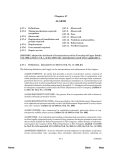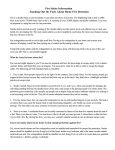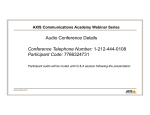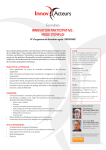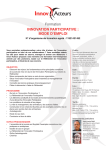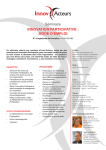Download Webinar Q&A session: An overview of SAR for devices intended to
Transcript
Webinar Q&A session: An overview of SAR for devices intended to be used next to the Human body Question 1 Right now we are about to look into CE LTE SAR testing, do you have any related guidance for the CE LTE SAR testing? As you many know, FCC had released KDB document (KDB 941225 D05) for the LTE SAR test consideration. Answer In terms of standards, the European standards for Head and Body SAR testing like EN 62209-1, EN 62209-2 and EN 62311 do not specifically address specific technologies such as LTE. The test guidance is relatively generic where they tend to provide guidance on device transmission settings, duty cycles, the modes to be covered, as well as considerations for antenna configurations and multiple operating modes where a device has multiple transmitters which can transmit simultaneously. For R&TTE Directive compliance where a device supports multiple modes of operation, if SAR testing is to be streamlined due to the various LTE modes, channel bandwidths and resource block allocations one way to minimize is by taking output power measurements for all of the modes and measuring in the modes which have a higher RF output and the same can be done where there are multiple transmit slots. We would be looking for the SAR report to include an explanation of the operating modes which were selected for test based on the power level, frequency and antenna used. The FCC KDB methodology would be recommended as it does provide clear guidance on channels, resource block allocations and channel bandwidth(s) that are to be tested based on the FCC lab guidance on LTE. Future releases of the IEC head and body standards will hopefully include more technology based guidance. The FCC KDB 941225 D05 procedure can be obtained from the FCC website from the Knowledge Database Publications page. Question 2 Isn’t there a higher limit for occupational use? Answer If a device can be categorized as intended for occupational usage (such as end users like Firemen and Police), any devices that fall within such a category would be subject to a higher SAR limit than the limit which applies to the general population usage which is 2.0W/kg. The occupational exposure limit for devices which are subject to head or body SAR is 10W/kg, while the occupational exposure limit for devices which are subject to limb SAR is even higher at 20W/kg. The FCC, in rule Part 2.1093 also specifies a higher limit for occupational use as does Industry Canada in their RF Exposure standards, RSS-102. Question 3 We have a GSM, and Bluetooth “walking” navigation device, can we apply EMF assessment per EN 62311 at the moment? It can be carried on the body or bundled on the arm. Answer Whether an EMF assessment should be carried out, depends on the intended use of the device. For example there are portable navigation devices which can operate while in a users pocket and for that type of use we would expect that the device is assessed for held to body configuration such as 0cm or 0.5cm. If the device contains GSM or GPRS, then the EN 62311 harmonized standard would be applicable for the near body operation for the GSM transmitter. If the device is to be assessed in held to body configuration, then SAR testing per Annex B of EN 62311 and EN 62209-2 would be appropriate. The issue with an EMF assessment, is that if usage is going to be within a few cm of the body, the limit will normally be exceeded due to the output power level for GSM which is applied in the calculation, in which case SAR testing would be necessary. For a Bluetooth portion, the EN 50371 standard or EN 62479 standard may apply if the average output power for the BT is less than 20mW. The Bluetooth transmitter would not be subject to SAR test and would also therefore be excluded from any simultaneous transmission assessment. If however, the BT transmitter average output is greater than 20mW, the EN 62311 and EN 62209-2 standard may be applied, and SAR tests can be carried out. For simultaneous transmission compliance for the device the GSM and BT maximum 10g SAR levels as obtained when each transmitter is assessed individually, can be summed in the respective configurations to obtain the 10g Sums for comparison to the limit. Regardless of whether the BT transmitter is deemed to comply with or without tests there must be documentation in accordance to the appropriate standard which describes the compliance rationale. The standards provide the reporting requirements. If the device is tested for SAR with a gap between the device and the SAR phantom, then the user instructions should provide guidance to the user on the distance at which they should operate the device from the body, so they are operating the device safely. Question 4 Are there any special warning/test needed for pregnant women concerning body worn SAR? Answer The R&TTE, FCC and Industry Canada RF Exposure legislation does not require any additional warning statements in the user information or any additional SAR tests for pregnant portable device users. This is due to the RF Exposure related research which is conducted such as RF penetration etc, already taking into account such exposure conditions and the legislation and standards therefore incorporate the provisions. The limits for SAR are also very conservative. Question 5 If a mobile phone is tested with a separation distance of 15mm or 25mm, does the user manual have to include the SAR related distance, like the FCC? Answer For R&TTE directive compliance we would be looking for the user information to provide RF Exposure guidance when there is a separation distance used for SAR testing of portable devices or the compliance boundary which is applicable which was applicable for any RF Exposure MPE calculations, primarily to inform the user as to how the manufacturer advises the device to be operated as well as the operational instructions to meet the R&TTE RF Exposure guidelines. If a mobile handset is tested with a 15mm or 25mm separation for near body usage, the user manual should state that a separation i.e. of 15mm or 25mm should be maintained between the device and the body during transmission or operation. It is also recommended, that for portable devices the user manual also provide guidance on approved holsters and any accessories which were subject to test. There is guidance in the EN 62209-2 standard which specifies that for evaluation of body SAR without a specific accessory, the separation distance used for SAR test cannot be more than 25mm. Question 6 For a USB dongle product which plugs into a Notebook, what type of SAR testing would be required? Is testing for the bottom and outer edge positions for the conservative consideration sufficient enough for CE SAR testing? Or do we just need to perform the SAR on the bottom position? Answer Based on the EN 62209-2 standard, the device should be positioned so that the peak SAR can be measured. The manufacturer’s intended use configuration needs to be considered for the device implementation. The test configurations you mention which is the bottom of the USB and the outer edge of USB would need to be included in the SAR evaluation. Additionally the user facing side of the USB would also need to be included in the assessment as well for R&TTE requirements. A USB device manufacturer would need to take into account that usb ports may be located on different sides of tablets or laptops and in different orientations, either horizontal or vertical receptacles. These variables related to the end use configuration forms the reasoning for assessment being carried out on all of the faces of the USB modem. Typically we would advise the USB device is tested with a modern laptop, similar to the FCC compliance methodology. One approach is to carry out area scans on the applicable sides of the USB to determine the worst case exposure position and then a full scan on the worst case side. That approach would be taken for each frequency, ensuring that each modulation and mode is considered in the test plan. If the USB dongle has a swivel function such that the antenna can rotate, there are additional considerations included in the EN 62209-2 specification. Question 7 What is the difference between the EN 50371 and EN 62479 standard? Answer The EN 62479 has additional methodologies (four possible compliance routes) of demonstrating compliance over that which EN 50371 covered. The EN 50371 standard provided mainly a basis that where the average output power emitted is less than or equal to 20mW and the transmitting peak is less than 20W then the apparatus was deemed to comply with the basic restrictions without testing. The EN 62479 standard provides four possible compliance routes, including the one listed in EN 50371 (See EN 62479 Section 4.1A - 4.1D and Section 4.2). The possible compliance routes are presented graphically on page 10 of EN 62479. Annex A.2 provides the Low power exclusion level (Pmax) which is, the SAR limit (2.0W/kg for general population exposure) multiplied by the averaging mass which is 10g for localised SAR. So the low power exclusion level, Pmax for general population exposure for localised SAR would be 20mW. For occupational exposure, the SAR limit is greater and therefore Pmax would be greater. Section 4 provides additional general considerations for example for transmitters where there is more than one antenna configuration, and also guidance on exposure for multiple transmitting sources (simultaneous transmission) Section 5 provides guidelines on the EN 62479 assessment reporting requirements. Section 6 provides guidance on the use of Measurement Uncertainty in the evaluation of compliance to limits. Annex B provides an alternate Pmax derivation for devices located within 25mm of the body and within 300MHz to 6GHz. Annex C provides compliance requirement for a pulsed field. The BS EN 62479: 2010 standard can be downloaded from BSOL as the BS EN has now been published.





